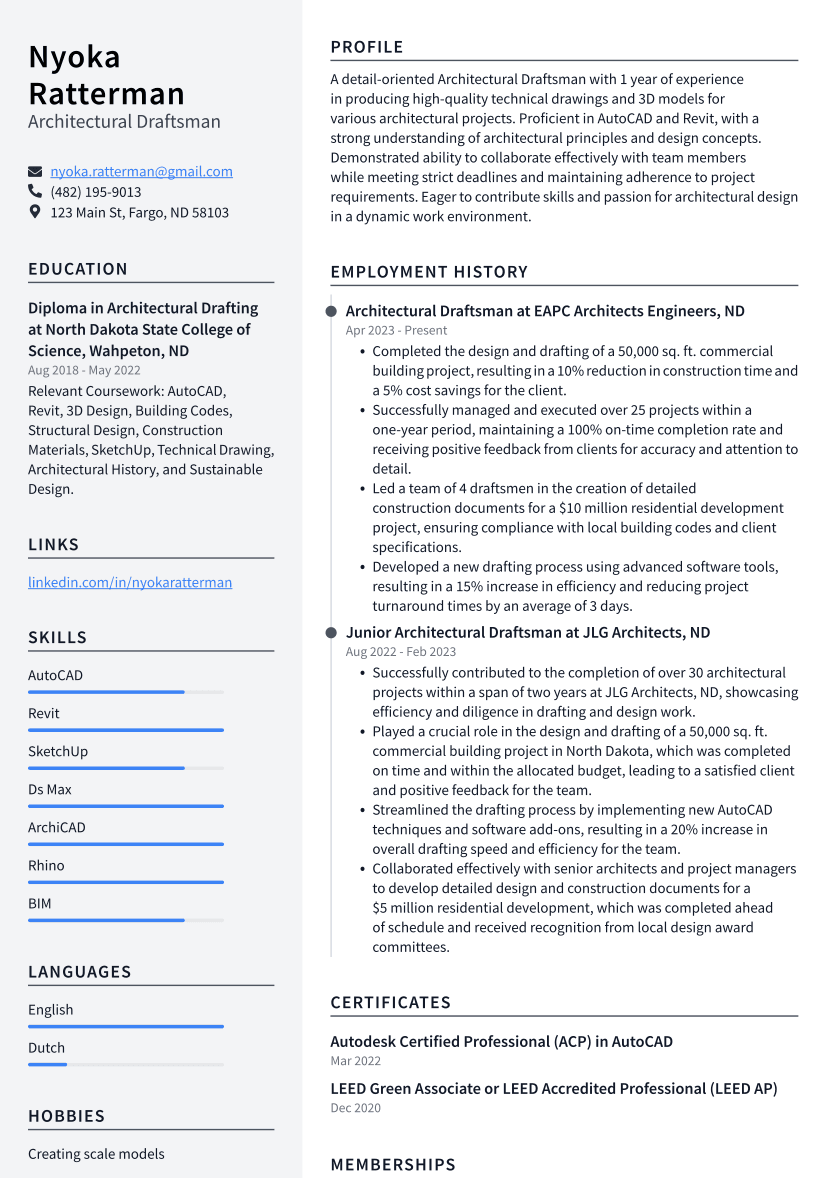Architectural Draftsman Resume Examples
Writing a great architectural draftsman resume is important because it is one of the first things a potential employer will see when they are considering you for a position. It is your opportunity to make a good first impression and sell yourself as the best candidate for the job.
Create your resume
Select from 7 professional resume templates
If you're looking for inspiration when it comes to drafting your own architectural draftsman resume, look no further than the samples below. These resumes will help you highlight your experience and qualifications in the most effective way possible, giving you the best chance of landing the architectural draftsman job you're after.
Essential Components of an Architectural Draftsman Resume
An Architectural Draftsman's resume is a critical tool for showcasing their expertise, experience, and capabilities in the realm of architectural design and drafting. It serves as a concise profile for employers to quickly assess a candidate's suitability for a role. Crafting an effective resume requires attention to detail and an emphasis on relevant qualifications, including technical proficiencies, work history, educational background, certifications, and a portfolio of work. This guide will delve into the integral elements of an Architectural Draftsman's resume, offering insights and tips to enhance each section for maximum impact.
1. Contact Information
Begin your resume with your contact information, ensuring it is accurate and up-to-date. This section connects you with potential employers and should include your full name, job title (Architectural Draftsman), phone number, and a professional email address. Consider adding your LinkedIn profile and online portfolio URL to provide further insight into your qualifications and work samples.

Regularly check your listed contact methods to respond promptly to employer inquiries, and remember to exclude excessive personal details unless specifically requested by the employer.
2. Objective Statement
The Objective Statement is a brief and impactful introduction at the top of your resume. It should articulate your career aspirations and how they align with the prospective employer's needs. Tailor this statement for each application to reflect the job description and the company's objectives.
Example: "Detail-oriented Architectural Draftsman with 5 years of experience seeking a position at XYZ Company to apply my proficiency in AutoCAD and Revit, contributing to innovative and sustainable design solutions."
Related: Top Architectural Draftsman Resume Objective Examples
3. Skills and Competencies
The Skills and Competencies section is a snapshot of your technical and soft skills relevant to architectural drafting. Highlight your proficiency in CAD software, knowledge of architectural principles, attention to detail, mathematical acumen, problem-solving, communication, time management, creativity, and familiarity with building codes and regulations.
Related: Architectural Draftsman Skills: Definition and Examples
4. Work Experience
The Work Experience section chronicles your professional journey, emphasizing roles and achievements pertinent to architectural drafting. Detail your use of specific drafting tools and software, and quantify accomplishments where possible. Include company names, job titles, dates of employment, and concise descriptions of your responsibilities and successes.
Highlight teamwork and collaboration experiences, as well as any initiatives you took to improve processes or reduce errors.
5. Education and Certifications
Under Education and Certifications, list your highest level of education first, followed by relevant courses, training, and certifications, such as those from The American Design Drafting Association (ADDA). Include workshops and seminars to demonstrate your commitment to continuous learning and staying abreast of industry trends.
Related: Architectural Draftsman Certifications
6. Portfolio of Work/Projects
A Work/Projects Portfolio showcases your technical skills, creativity, and problem-solving abilities through a curated selection of blueprints, 3D models, and completed projects. Accompany each sample with a brief description, highlighting your role and any challenges overcome. Maintain both online and offline versions of your portfolio for accessibility and convenience.
Focus on quality over quantity, presenting your most impressive and relevant work.
7. References
Including references from industry professionals, such as past employers, instructors, or colleagues, can enhance your resume by providing testimonials to your skills and work ethic. Obtain permission before listing individuals as references and opt for the phrase "References available upon request" if direct contact details are not required upfront.
Remember, references should complement a well-constructed resume and cover letter, serving as additional validation of your qualifications.
By refining each section of your resume with the guidance provided, you can create a compelling and professional representation of your qualifications as an Architectural Draftsman, positioning yourself as an ideal candidate for potential employers.